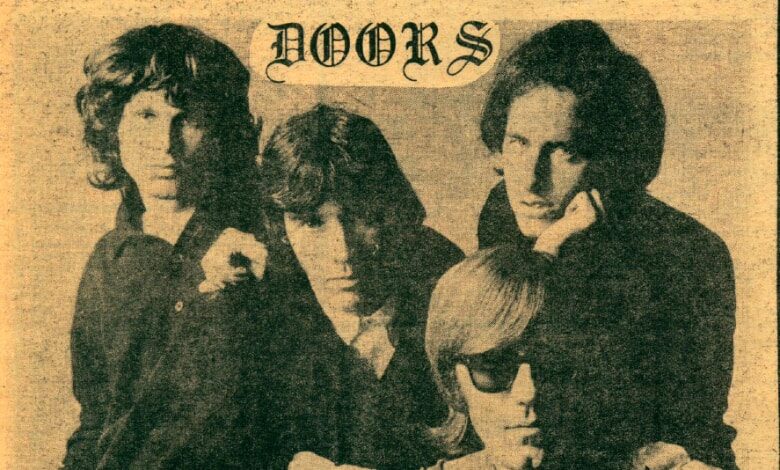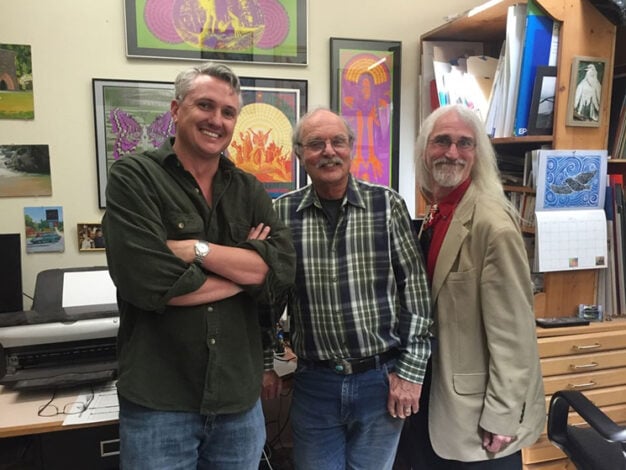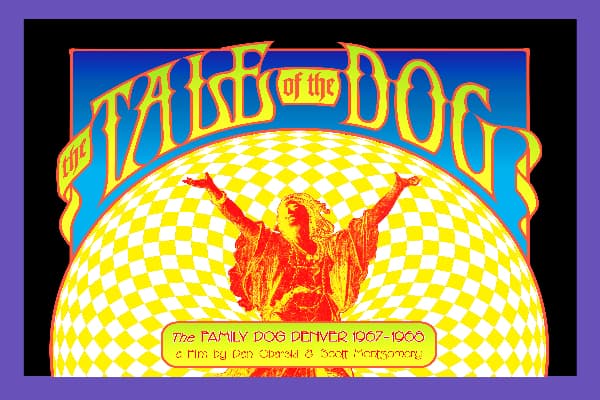How a Health Care Professional Rediscovered Denver’s Grand Musical Past
'Tale of the Dog' co-director shares brush with Hollywood, rock immortality

I had just finished doing a psychological evaluation at a Denver mental health center on a schizophrenic homeless man and was eating lunch. It was 2006.
The Doors’ “Riders on the Storm” had come on the radio, and I instinctively looked them up online for some passive reading. Suddenly, I was staring at a grainy photo of Jim Morrison playing a fraternity rush party at the University of Denver.
As a Denver native and huge Doors fan, I couldn’t believe it. Nothing cool from the 1960s had ever happened here, or so I thought.
Jump to 2021, and my co-filmmaker Scott Montgomery and I were signing a North American distribution deal with Cinedigm for “The Tale of the Dog.” The 100-minute documentary unearths the vanished story of the most important music venue in Denver’s history.
The Family Dog Denver, as it was known during the late 1960s, hosted Morrison and the Doors the day after that photo was snapped at DU.
I am not – or rather, was not – a filmmaker at the time.
I’ve been in healthcare for 22 years, as a licensed professional counselor and a health plan administrator. I had zero notions of taking a filmmaker’s tour through Hollywood. But life is strange, and sometimes as you’re driving through it you see a road that’s not on your itinerary, and you feel compelled to turn the wheel.
Once you do, your life is never the same.
The First Step Is the Biggest
I’d never heard a single mention of the Family Dog before this journey. My friends and I were Gen Xers who lived on the music of the ’60s and ’70s, and we knew about the famous rock clubs like The Fillmore and The Avalon, plus the San Francisco and Greenwich Village music scenes.
Because it had all been documented. Thoroughly. It was all over and there was nothing left to be said or done but to enjoy the music and memories.
Until I saw that photo of Morrison in Denver.
As it turned out, there was a 1960s archeological opportunity that had been totally missed.
History is always incomplete.
The Family Dog, we discovered, was the reason Denver became a music epicenter. It was a magical, mystical place; an Avalon Ballroom opened by San Franciscans in the dusty city’s industrial borderlands that hosted the Pharaohs of Rock and Blues: Janis Joplin, Jimi Hendrix, Grateful Dead, Howlin’ Wolf, Jefferson Airplane and, of course, the Doors.
Those highly collectible psychedelic posters done for a select few venues of the 1960s? They were also made for the Family Dog Denver.
The lightshows we’ve come to expect as a fundamental part of concerts? One of the world’s first, and perhaps for a time, largest, liquid light shows ran at the Denver Dog, as many called it.
The electronic music that’s the foundation of a vast amount of today’s music’s landscape? One of its pioneers, Lothar and the Hand People, cut their teeth at the Family Dog, while, ruefully, rejecting a contract offer from Elektra Records that instead immediately went to Morrison and the Doors.
Canned Heat, the bang-up blues band who wrote the Woodstock anthem “Going Up the Country,” never made a cent on their hits. Why? Because they got busted for drug possession before a show at the Family Dog and lost all their publishing rights.
It’s cost them millions.
Perhaps the most outstanding aspect of the Family Dog’s existence was how it showcased what it looks like when cultures collide.
When the citizens of 1967 Denver, who had defeated the Nazis and fought in Korea, saw their kids doing LSD, dressing like screwballs and running off to foul hippie flophouses downtown, alarm bells went off citywide.
The Flower Power Era, Up Close
The mayor demanded the Family Dog, seen as the offending agent, be shut down. A singular character, Detective John Gray of the Denver Police Department, emerged to lead the charge against the “hippie scourge.”
The resulting battles led straight to court, a premature closing of the Dog and an ill will still carried by those who are still around 55 years later.
Despite this rich history, there was a huge problem in trying to assemble a full understanding of it for the documentary. That was because, quite bizarrely, there existed no photos and no video of the venue. Somehow the Family Dog had totally disappeared from memory.
In 2015, after years of scratching the dirt around this mysterious concert hall, my wife, Nancy, saw an advert for a psychedelic poster show at a local museum. “Look, it’s about the Family Dog, babe. We should go.”
In what would become a hinge moment, we did.

The show was put on by Scott Montgomery, an art history professor at the University of Denver. I didn’t know him from Adam, but Scott was the only person I’d ever met who had even heard of the Family Dog.
Coincidentally from the Bay area, he had come to the mystery of this place via his own route, often focused on the shows’ psychedelic posters. At the end of his presentation, feeling a rising sense of opportunity, I wrote in his guestbook, “We have to get together!”
After several months we did, instantly falling into a frenzied exchange of emancipated enthusiasm and a discussion of what exactly to do with this story.
We initially thought we’d write an article, or a maybe a book. But the old musicians were increasingly dying, and there was a palpable sense of urgency to capture their histories in maximal fashion.
“We have to get these people on camera! Let’s do a documentary!” we cheered, as if we had just solved, rather than created, an enormous problem.
The problem was that neither of us had the foggiest idea of what that meant.
If you asked me now if I would do it again, I would avoid the question, because it was a ludicrous amount of work. We thought we’d be done in eight months. Maybe a year.
It took six years.
The story we unearthed was so relatively vast and original, and the road was so heady, difficult and gratifying, that I’ll hold onto it as one of the most personally valuable things I’ve ever done.
What’s the first thing you say after you declare you’re doing a documentary and you haven’t a clue what you’re doing? An ocean of questions floods the picture:
- Are we interviewing people? How?
- Do we need videographers? Who?
- Are we raising money? How much?
- Do we know relevant people? Which ones?
- Are we comfortable we know the whole story? How do we find out?
- Do we need to create a company? What kind? We need a lawyer!
You get the idea.
The fuel required to solve these problems was our entrancement with the story unfurling before us. It was the critical ingredient, without which the process would have been unsurvivable.
We walked blindly into starting a production company. There is a real bliss to “unknown unknowns,” and we quickly learned that every component of running such a business had to be both discovered and successfully executed upon. If we didn’t keep the foot on the gas this thing would drag on for a decade.
It’s plenty of fun to tell people you’re doing a documentary and bask in their approving responses, but the hard truth is, until you have a final film, you have nothing.
Crash Course in Moviemaking 101
Like a business deal that remains a figment until a contract is signed, this film was pure fantasy right until the minute it was completed. This was my ever-present, terrifying and motivating reality.
Each piece of the business – operations, financials, research, cast, storyline, editing, promotion and so on – was an entirely new puzzle that had to be solved. There were a fair share of days over those six years, toiling in the nowheresville of the the belly of the process, when an end seemed like an impossibility.
But, for our efforts, we were treated to a wonderland of new experiences, including a virtual red carpet at the Indiedance Film Festival that illuminated our dark days during COVID-19, inspiring the legendary Colorado classic rock DJ Rick Lewis. I’ve listened to him since high school, and he not only narrated the film but invited us on his renowned radio station to promote the finished movie.
There were big, harrowing moments along the way, too.
Hundred-year rains that shut down airports across Southern California and caused massive sinkholes on Ventura Boulevard almost got us murdered by a lunatic during a very-Los Angeles road rage.
Mother Nature also nearly cost us our interview with Canned Heat.
Because of the rains, our videographers were stranded in Denver, and we had no equipment for the following day’s shoot. Now, would you imagine that Hollywood could run out of video cameras? Because they did.
As if in a bad hallucination, it turned out it was the first day of pilot shoots for the studios, and it took us a full 10 hours of driving around LA before finding a far-flung rental shop and what might have actually been the last camera in Hollywood.
The contents of the Canned Heat interview would become the dramatic lynchpin of the film.
Family Reunion, Denver Style
There were merry moments, too, like when we reunited the Family Dog employees, patrons, bands and enthusiasts on the 50th anniversary of its opening for a grand party (and lots of interviews). Dozens of 70 – 85-year-olds flew in from around the country to celebrate what was, in their own words, a permanently transformational association.
The Dog meant that much.
But there was the final, radiant moment, and that was when I turned on my TV and saw “The Tale of the Dog” available to watch on Amazon, Apple TV, GooglePlay and other streaming services. Years of toil shrunk to a diamond of an instant, and a total recalibration to the possibilities lurking in life’s halftones.
I’ve become convinced that naïveté runs the world. In the end we walked like babes into a jungle. But our enthusiasm and willingness to do whatever it took to get the full, objective story, combined with the universe’s uncanny receptivity to meeting us halfway, produced that unlikely final film.
So now I’m back in healthcare, like an old timer reminiscing on his front porch about the, yes, long strange trip it’s been, a more robust and enriched person in many ways.
And with an eye out for those compelling roads not on my itinerary.
“The Tale of the Dog” is currently streaming on Amazon, iTunes, Google Play, YouTube, Vudu, Tubi TV, and Hoopla.
Dan Obarski is a healthcare director and Licensed Professional Counselor in Denver.

